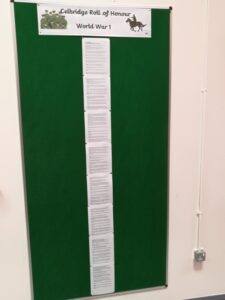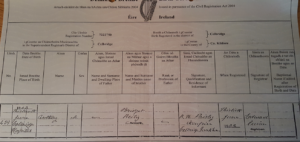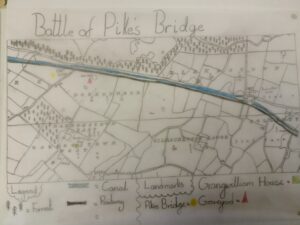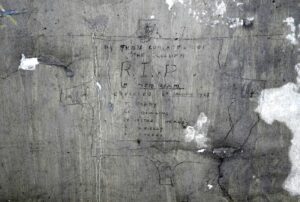Introduction
As the History Squad of 2016 we have decided to tell the story of a local man called Hubert Michael O’Connor. In preparing our school to accept our National Flag we asked pupils to bring in to school any information they might have on relatives who took part in the
Easter Rising of 1916. We first read the name ‘Hubert Michael O’Connor’ in a witness statement of Col. Padraig O’Conchubhair. Mr. O’ Conchubhair said that he joined the Volunteers in Celbridge where Hubert O’Connor was one of its leading officers. We believe
that Hubert’s life story should be told and his memory kept alive. In researching his story we learned much about the past and came across many questions which we tried to answer. Why would a Volunteer who was in charge of 200 men join the British Army and fight against Germany? Was Hubert O Connor ‘a man for others’? What was it like for Hubert on August 16th 1917, the day he was severely wounded in WW1? Why is very little known about him by the people of Celbridge, his home town?
The Early Years
Hubert was born in Jan. 1887 in a house called The Grove, in Celbridge. This white building still stands and is surrounded by a large housing estate called ‘The Grove.’ His
father Charles was born in Limerick and his mother Marion was from Meath. Charles was a Medical Doctor. The family were Roman Catholic, could all read and write, spoke English and according to the 1901 Census had a female servant called Mary Cuite. Between 1903 and1908, a total of 19 orphans were admitted to the Abbey National School which was situated on the bank of the Liffey, just opposite Hubert’s home. Dublin city, at the beginning of the 20th century, had the largest slums in all of Europe. Orphans came to Celbridge and were looked after locally by families paid to do so. The population of the village stood at 811 in the 1901 census. When Hubert was four years old there was a huge celebration up at the big
house Castletown. Thomas Connolly had ‘Come of age’ and there was a huge party with fireworks and bonfires. Celbridge was a small village with both poor and rich living side by side. There is no evidence that Hubert went to the local Primary School the Abbey but we do know that when he reached 11 years of age he entered Clongowes College, Clane. This was to have a huge affect on his life and beliefs.
Life at Clongowes 1898-1904.
As part of our research, we visited Clongowes College on Feb.4th 2016. There we met Margaret Doyle, History Archivist. She told us about the College, WW1 and Hubert O’Connor. The College, founded by the Jesuits, opened to students in 1814. It is one of
Ireland’s oldest Catholic schools. Hubert, affectionately known as Hugh, started in Clongowes aged 11. His father, Dr. Charles, was the Medical Adviser to the College and also to the girl’s Collegiate College in Celbridge. By this time the family had grown. Hubert now had a younger sister Helen and two brothers Francis and Carl. Hugh was to study at Clongowes and become a vibrant part of its community during the next six years. His fellow students described him as popular, good at rugby and cricket and kind. The whole belief of the Jesuits was to educate a young boy into becoming ‘A Man for Others’. Looking at this boy’s younger life it is clear to see he was on the path to becoming just such a man. Headmaster, Fr. Tomkin wrote, ‘He imbued the school ethos that ‘the highest duty of a gentleman was in every circumstance of life to play the game’.
When Hugh was 15, an important meeting of 3,000 people took place in Celbridge. Patrick Pearse spoke, encouraging all present to learn how to speak the Irish language and urged them to support Irish industries. Dr. O’ Connor, Hugh’s father was elected vice president of the Celbridge Branch of the Gaelic League. Hugh must have been very proud of his Dad. We see that his sister went on to learn how to speak Irish. Did this influence him in joining the Volunteers?
Ms. Doyle told us that John Redmond was a student of Clongowes also. Did this man influence Hugh in future decisions? Like our local man Mr. Redmond went on to attend Trinity College. Mr. Redmond believed Ireland had a right to self-government. He thought that if Irish men joined the British army to fight for Catholic Belgium against the Germans, then when the war was over we would gain Home Rule. Hugh enrolled in Trinity College
when he was seventeen and studied to become a Barrister. He then became part of the Leinster Circuit. Like Mr. Redmond he was interested in politics. Hubert Michael O’Connor contested the East Limerick election in 1910, aged 23 as an Independent Nationalist. He was unsuccessful.
The Irish Volunteers were founded in 1913 in answer to the Ulster Volunteer Force. The U.V.F. did not want Home Rule which John Redmond managed to get passed in the House of Commons in 1912. Hugh was a leading member of the Volunteers in Celbridge which numbered about 200 men. He took part in the Howth gun run and the Kilcoole gun run. About twenty-five rifles and ammunition were taken to Celbridge. The Celbridge Volunteers paraded at Bodenstown where Pearse made his famous address.
With the outbreak of war, Hugh decided to follow the urgings of John Redmond to join up and fight with the hope of gaining Home Rule. The Volunteers were split with the bulk going ‘Redmondite’. Hugh, who was responsible for the rifles and ammunition handed these over to Art O’Connor, who lived in Elm Hall, Celbridge. Hugh enlisted through Trinity College with the Officers Training Corps. The provost of Trinity said he was of fine moral character. He joined the King’s Light Shropshire Infantry, 6th Battalion in Sept. 1914 and was made Captain in 1915. The men were to fight alongside the 60th Division and landed in Boulogne on 22nd July 1915. They served entirely on the western Front. Celbridge had 200 men fighting at the front in 1915 which was a considerably large
part of the male population.
Life at the front consisted of trenches, wire defences and mined dugouts. Conditions never witnessed before existed here. The smells, the mud and the lice made life very difficult. A new type of warfare called ‘siege warfare’ was used. This meant bombard the
enemy trenches first, then charge ‘over the top’. Success was counted in gains of yards rather than miles. In July 1916, at the start of the battle of the Somme, Hugh trained and led a successful raid into the enemy’s trenches. This would have been a terrifying ordeal with hand to hand combat. After the withdrawal he went out into no-man’s-land under heavy gunfire to bring in wounded men. For this gallant action he was awarded the MC for conspicuous bravery. This was written about in the Supplement to The London Gazette, 19th of Augugust 1916. This remarkable action shows his loyalty to his men.
The following year saw Hugh involved with his 6th Battalion in what was to become a slaughter of almost half a million men. This was ‘The Third Battle of Ypres’ or Passchendaele. Conditions led soldiers to call this ‘Hell on earth’. The battle of Langemark
took place on the 16th and 17th of Aug. 1917. It was the second in a list of eight battles. Two days before, the rain poured down for hours. The whole area was a quagmire of mud and broken trees. Corpses lay scattered in the thick Flanders mud. Conditions were so bad that horses and men simply disappeared into water filled craters. On the morning of the 16th fog and battle smoke filled the air and made it hard to see the German troops. Fighting would be
fierce. The 6th Batt. were to attack the village from the right. Hugh, according to his Colonel was in good spirits urging his men forward. They gained their objective and Hugh was organising his men when he was shot in the groin. As he was being carried back to the rear on a stretcher he was hit on the leg. All he wanted to know was how his officers and men were doing. The next day he received the Last Sacraments and died of his wounds. His Col. said he was not in much pain and died peacefully. In his belongings was his pipe cleaner so we know he smoked. He had a rosary, crucifixes and medallions so he must have been religious. He left £157 to his mother and £4 to his soldier servant Pte. Cornelius. He is buried in Dozinghem Military Cemetery, West Flanders, Belgium.
At the start of this essay we asked was Hubert O’Connor ‘A Man for Others’? We believe everything about him shows he was. Playing cricket and rugby in Clongowes, dragging in wounded men from the battle-field, checking were his men all right even as he was dying and finally thinking of his servant in his will are proof of this.
His death had an impact on his family and we are told ‘It would be an exceptionally heavy blow’ for his father. His friends would not forget him. His name is on the Roll of Honour in Trinity, in Clongowes and in the Four Courts. However Ireland was a changed
country after the war and its people were too busy fighting for Independence to mourn such vast numbers of dead. In time he was forgotten among the 310,000 casualties of Ypres. The search for his past was like looking for a needle in a haystack, but we have told his story and will remember him.
“So here while the mad guns curse overhead and tired men sigh with mud for couch and floor
Know that we fools now with the foolish dead
Died not for flag, nor King nor Emperor But for a dream, born in a herdsman’s shed
And for the secret scripture of the poor.”
By Tom Kettle 1880-1916,
(fellow Volunteer, Barrister and Redmondite).
Bibliography
Primary Sources:
The Clongownian, 1917 and 1918.
The Kildare Observer,1902.
The London Gazette, Aug. 1916.
Bureau of Military History 1913-21. File S-182.
Census of Ireland 1901 and 1911.
Military Award Records of H.M.O’Connor, Kew, England.
Secondary Sources:
On The One Road, James Durney, Leinster Leader, 2001.
Wigs and Guns, Anthony P. Quinn, Four Courts Press, 2006.
www.scoilnet.ie
www.nationalarchives.ie
http://www.cwgc.org/
www.bbc.co.uk/history










 (9)
(9)







 (18)
(18) (19)
(19) 
 (24)
(24)







 (37)
(37)



 Anthony O’ Reilly was the only one of these men executed and we wanted to learn more about him. Local historian Jim Doyle has done extensive research on O’ Reilly and he came to speak to us.
Anthony O’ Reilly was the only one of these men executed and we wanted to learn more about him. Local historian Jim Doyle has done extensive research on O’ Reilly and he came to speak to us.

 [ 11]
[ 11]
 [13]
[13]

 “Treachery on the 1st December 1922 in that they at Leixlip assisted certain armed persons in using force against the National troops.”
“Treachery on the 1st December 1922 in that they at Leixlip assisted certain armed persons in using force against the National troops.”





